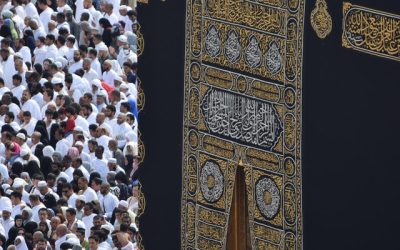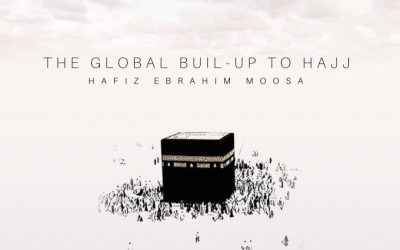Little is known of the pre-Islamic history of the Kaaba.
* Wensinck, writing in the Encyclopedia of Islam, identifies it with a place called Macoraba mentioned by the Roman geographer Ptolemy mention of Mecca. Ptolemy's text is believed to date from the second century CE., before the rise of Islam.Wensinck, A. J; Ka`ba. Encyclopaedia of Islam IV p. 318 Patricia Crone, in Meccan Trade and the Rise of Islam, believes that this identification is false, and that Macoraba was a town in southern Arabia, in what was then known as Arabia Felix.
* According to The Encyclopaedia Britannica, "before the rise of Islam it was revered as a sacred sanctuary and was a site of pilgrimage."
* According to the German historian Eduard Glaser, the name "Kaaba" may have been related to the southern arabian or Ethiopian word "mikrab", signifying a temple. Again, Crone disputes this etymology.
Muslim accounts, and some accounts written by academic historians, stress the power and importance of the pre-Islamic Mecca. They depict it as a city grown rich on the proceeds of the spice trade. Crone believes that this is an exaggeration and that Mecca may only have been an outpost trading with nomads for leather, cloth, and camel butter.
Crone argues that if Mecca had been a well-known center of trade, it would have been mentioned by later authors such as Procopius, Nonnosus, and the Syrian church chroniclers writing in Syriac. However, the town is conspicuously absent from any geographies or histories written in the last three centuries before the rise of Islam.
The Muslim view of the Kaaba's early history:
According to the qur'an, the Kaaba was built by ibrahim (abraham) and his son Ismail (ishmael http://www.usc.edu/dept/MSA/quran/002.qmt.html#002.127). Later Muslim traditions assert that the Kaaba "reflects" a house in heaven called al-Baytu l-Ma'mur and that it was first built by the first man, adam. Ibrahim and Ismail rebuilt the Kaaba on the old foundations.
The Kaaba at the time of Muhammad Sallallahu Alayhi Wa Sallam Sallallahu Alayhi Wa Sallam:
All Muslims, and many if not all historians, accept the following account:
At the time of Muhammad Sallallahu Alayhi Wa Sallam, his tribe, the Quraysh, was in charge of the Kaaba, which was at that time a shrine to numerous Arabian tribal gods. Muhammad Sallallahu Alayhi Wa Sallam earned the enmity of his tribe by claiming their shrine for the religion of Islam that he preached. He wanted the Kaaba to be dedicated to the worship of God (allah) alone, and all the other statues evicted. The Quraysh persecuted and harassed him continuously, and he and his followers eventually migrated to medina in 622 CE. After this pivotal migration, or Hijra, the Muslim community became a political and military force. In 630 CE, Muhammad Sallallahu Alayhi Wa Sallam and his followers returned to Mecca as conquerors and the Kaaba was re-dedicated as an Islamic house of worship. Henceforth, the annual pilgrimage was to be a Muslim rite, the Hajj.
Islamic histories also mention a reconstruction of the Kaaba in the late 500s, when Muhammad Sallallahu Alayhi Wa Sallam was a young man. A story found in ibn ishaq's Sirat Rasul Allah (as reconstructed and translated by Guillaume) shows the young Muhammad Sallallahu Alayhi Wa Sallam as settling a quarrel between Meccan clans as to which clan should set the cornerstone in place. Muhammad Sallallahu Alayhi Wa Sallam had all the clan elders raise the cornerstone on a cloak; he then nudged the stone into place. Ibn Ishaq says that the timber for the reconstruction of the Kaaba came from a Greek ship that had been wrecked on the Red Sea coast at Shu'ayba.
It is also claimed by the shi'a that the Kaaba is the birth place of ali ibn abi talib, the fourth caliph and the cousin and son-in-law of the Islamic prophet Muhammad Sallallahu Alayhi Wa Sallam.
The Kaaba from Muhammad Sallallahu Alayhi Wa Sallam's time to the present day:
The Kaaba has been repaired and reconstructed many times since Muhammad Sallallahu Alayhi Wa Sallam's day.
* abd-allah ibn al-zubayr, an early Muslim who ruled Mecca for many years between the death of the fourth caliph (or first Imam, by Shi'a reckoning) and the consolidation of ummayad power, is said to have demolished the old Kaaba and rebuilt it to include the Hateem, a semi-circular wall now outside the Kaaba. He did so on the basis of a tradition (found in several hadith collections ) that the Hateem was a remnant of the foundations of the Abrahamic Kaaba, and that Muhammad Sallallahu Alayhi Wa Sallam himself had wished to rebuild so as to include it.
* This structure was destroyed (or partially destroyed) in 683, during the war between al-Zubayr and Umayyad forces commanded by al-Hajjaj bin yousef. Al-Hajjaj used stone-throwing catapults against the Meccans. This episode has been depicted by many Muslim chroniclers as a black mark against the Ummayad caliph yazid i, who ordered the campaign against Mecca. Yazid died in 683, the year his forces attacked the Hijaz.
* The Ummayads under abdul malik bin marwan finally reunited all the former Islamic possessions and ended the long civil war (see first islamic civil war). In 693 he had the remnants of al-Zubayr's Kaaba razed, and rebuilt on the foundations set by the Quraysh. The Kaaba returned to the cube shape it had taken during Muhammad Sallallahu Alayhi Wa Sallam's lifetime.
The basic shape and structure of the Kaaba have not changed since those long-ago events. However, many repairs and partial reconstructions have been made, under many rulers.





0 Comments